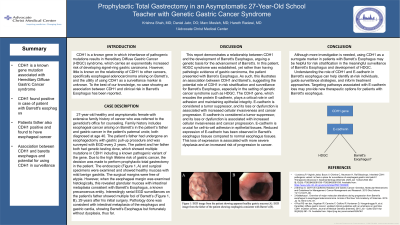Sunday Poster Session
Category: Stomach
P1677 - Prophylactic Total Gastrectomy in an Asymptomatic 27-Year-Old School Teacher with Genetic Gastric Cancer Syndrome
Sunday, October 27, 2024
3:30 PM - 7:00 PM ET
Location: Exhibit Hall E

Has Audio

Krishna Shah, MD
Advocate Christ Medical Center
Chicago, IL
Presenting Author(s)
Daniel Jabr, DO1, Krishna Shah, MD2, Harreth Raddawi, MD1, Marc Mesleh, MD1
1Advocate Christ Medical Center, Oak Lawn, IL; 2Advocate Christ Medical Center, Chicago, IL
Introduction: CDH1 is a known gene in which inheritance of pathogenic mutations results in Hereditary Diffuse Gastric Cancer (HDGC) syndrome, which carries an exponentially increased risk of developing signet-ring gastric carcinoma. However, little is known on the relationship of CDH1 to other cancers, specifically esophageal adenocarcinoma arising on Barrett’s, and the utility of using CDH1 as a surveillance marker is unknown. To the best of our knowledge, no case showing an association between CDH1 and clinical risk in Barrett’s Esophagus has been reported.
Case Description/Methods: We present a 27-year-old healthy and asymptomatic female with extensive family history of cancer who was referred to the geneticist's office for counseling. Family history includes esophageal cancer arising on Barrett’s in the patient’s father and gastric cancer in the patient’s paternal uncle, both diagnosed at age 40. The patient’s father had undergone an esophagectomy with gastric pull-up procedure and was surveyed with EGD every 2 years. The patient and her father both had genetic testing done, which showed multiple mutations in CDH1 including a known pathogenic variant of the gene. Due to the high lifetime risk of gastric cancer, the decision was made to perform prophylactic total gastrectomy in the patient. The endoscopic (Figure 1, A) and surgical specimens were examined and showed healthy mucosa with mild benign gastritis. The surgical margins were free of atypia. However, when the esophageal margin was examined histologically, this revealed glandular mucosa with intestinal metaplasia consistent with Barrett's Esophagus, a known precancerous entity. Interestingly serial EGD surveillances on the patient’s father showed multiple foci of Barrett’s (Figure 1, B), 29 years after his initial surgery. Pathology done was consistent with intestinal metaplasia of the esophagus and gastric cardia, showing Barrett’s Esophagus but fortunately without dysplasia, thus far.
Discussion: This report demonstrates a relationship between CDH1 and the development of Barrett's Esophagus, arguing a genetic basis for the advancement of Barrett’s. In this patient, HDGC syndrome was established, yet rather than having pathologic evidence of gastric carcinoma, the patient presented with Barret’s Esophagus. As such, this illustrates an association between CDH1 and Barret’s, suggesting the potential role of CDH1 in risk stratification and surveillance for Barrett’s Esophagus, especially in the setting of genetic cancer syndrome such as HDGC.

Disclosures:
Daniel Jabr, DO1, Krishna Shah, MD2, Harreth Raddawi, MD1, Marc Mesleh, MD1. P1677 - Prophylactic Total Gastrectomy in an Asymptomatic 27-Year-Old School Teacher with Genetic Gastric Cancer Syndrome, ACG 2024 Annual Scientific Meeting Abstracts. Philadelphia, PA: American College of Gastroenterology.
1Advocate Christ Medical Center, Oak Lawn, IL; 2Advocate Christ Medical Center, Chicago, IL
Introduction: CDH1 is a known gene in which inheritance of pathogenic mutations results in Hereditary Diffuse Gastric Cancer (HDGC) syndrome, which carries an exponentially increased risk of developing signet-ring gastric carcinoma. However, little is known on the relationship of CDH1 to other cancers, specifically esophageal adenocarcinoma arising on Barrett’s, and the utility of using CDH1 as a surveillance marker is unknown. To the best of our knowledge, no case showing an association between CDH1 and clinical risk in Barrett’s Esophagus has been reported.
Case Description/Methods: We present a 27-year-old healthy and asymptomatic female with extensive family history of cancer who was referred to the geneticist's office for counseling. Family history includes esophageal cancer arising on Barrett’s in the patient’s father and gastric cancer in the patient’s paternal uncle, both diagnosed at age 40. The patient’s father had undergone an esophagectomy with gastric pull-up procedure and was surveyed with EGD every 2 years. The patient and her father both had genetic testing done, which showed multiple mutations in CDH1 including a known pathogenic variant of the gene. Due to the high lifetime risk of gastric cancer, the decision was made to perform prophylactic total gastrectomy in the patient. The endoscopic (Figure 1, A) and surgical specimens were examined and showed healthy mucosa with mild benign gastritis. The surgical margins were free of atypia. However, when the esophageal margin was examined histologically, this revealed glandular mucosa with intestinal metaplasia consistent with Barrett's Esophagus, a known precancerous entity. Interestingly serial EGD surveillances on the patient’s father showed multiple foci of Barrett’s (Figure 1, B), 29 years after his initial surgery. Pathology done was consistent with intestinal metaplasia of the esophagus and gastric cardia, showing Barrett’s Esophagus but fortunately without dysplasia, thus far.
Discussion: This report demonstrates a relationship between CDH1 and the development of Barrett's Esophagus, arguing a genetic basis for the advancement of Barrett’s. In this patient, HDGC syndrome was established, yet rather than having pathologic evidence of gastric carcinoma, the patient presented with Barret’s Esophagus. As such, this illustrates an association between CDH1 and Barret’s, suggesting the potential role of CDH1 in risk stratification and surveillance for Barrett’s Esophagus, especially in the setting of genetic cancer syndrome such as HDGC.

Figure: Figure 1A: EGD image from the patient showing apparent healthy gastric mucosa; Figure 1B: EGD image from patients father showing findings consistent with Barett's
Disclosures:
Daniel Jabr indicated no relevant financial relationships.
Krishna Shah indicated no relevant financial relationships.
Harreth Raddawi indicated no relevant financial relationships.
Marc Mesleh indicated no relevant financial relationships.
Daniel Jabr, DO1, Krishna Shah, MD2, Harreth Raddawi, MD1, Marc Mesleh, MD1. P1677 - Prophylactic Total Gastrectomy in an Asymptomatic 27-Year-Old School Teacher with Genetic Gastric Cancer Syndrome, ACG 2024 Annual Scientific Meeting Abstracts. Philadelphia, PA: American College of Gastroenterology.
